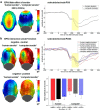Perceived communicative context and emotional content amplify visual word processing in the fusiform gyrus
- PMID: 25878274
- PMCID: PMC6605166
- DOI: 10.1523/JNEUROSCI.3346-14.2015
Perceived communicative context and emotional content amplify visual word processing in the fusiform gyrus
Abstract
The personal significance of a language statement depends on its communicative context. However, this is rarely taken into account in neuroscience studies. Here, we investigate how the implied source of single word statements alters their cortical processing. Participants' brain event-related potentials were recorded in response to identical word streams consisting of positive, negative, and neutral trait adjectives stated to either represent personal trait feedback from a human or to be randomly generated by a computer. Results showed a strong impact of perceived sender. Regardless of content, the notion of receiving feedback from a human enhanced all components, starting with the P2 and encompassing early posterior negativity (EPN), P3, and the late positive potential (LPP). Moreover, negative feedback by the "human sender" elicited a larger EPN, whereas positive feedback generally induced a larger LPP. Source estimations revealed differences between "senders" in visual areas, particularly the bilateral fusiform gyri. Likewise, emotional content enhanced activity in these areas. These results specify how even implied sender identity changes the processing of single words in seemingly realistic communicative settings, amplifying their processing in the visual brain. This suggests that the concept of motivated attention extends from stimulus significance to simultaneous appraisal of contextual relevance. Finally, consistent with distinct stages of emotional processing, at least in contexts perceived as social, humans are initially alerted to negative content, but later process what is perceived as positive feedback more intensely.
Keywords: EEG/ERP; emotion; fusiform gyri; language; social feedback; social neuroscience.
Copyright © 2015 the authors 0270-6474/15/356010-10$15.00/0.
Figures






Similar articles
-
People matter: Perceived sender identity modulates cerebral processing of socio-emotional language feedback.Neuroimage. 2016 Jul 1;134:160-169. doi: 10.1016/j.neuroimage.2016.03.052. Epub 2016 Mar 30. Neuroimage. 2016. PMID: 27039140
-
Emotion in Context: How Sender Predictability and Identity Affect Processing of Words as Imminent Personality Feedback.Front Psychol. 2019 Feb 1;10:94. doi: 10.3389/fpsyg.2019.00094. eCollection 2019. Front Psychol. 2019. PMID: 30774611 Free PMC article.
-
Language-based social feedback processing with randomized "senders": An ERP study.Soc Neurosci. 2018 Apr;13(2):202-213. doi: 10.1080/17470919.2017.1285249. Epub 2017 Feb 6. Soc Neurosci. 2018. PMID: 28103746
-
Distributed and interactive brain mechanisms during emotion face perception: evidence from functional neuroimaging.Neuropsychologia. 2007 Jan 7;45(1):174-94. doi: 10.1016/j.neuropsychologia.2006.06.003. Epub 2006 Jul 18. Neuropsychologia. 2007. PMID: 16854439 Review.
-
Electrophysiological Correlates of Romantic Love: A Review of EEG and ERP Studies with Beloved-Related Stimuli.Brain Sci. 2022 Apr 26;12(5):551. doi: 10.3390/brainsci12050551. Brain Sci. 2022. PMID: 35624939 Free PMC article. Review.
Cited by
-
Oscillatory EEG Signatures of Affective Processes during Interaction with Adaptive Computer Systems.Brain Sci. 2020 Dec 31;11(1):35. doi: 10.3390/brainsci11010035. Brain Sci. 2020. PMID: 33396330 Free PMC article.
-
The impact of negative emotions on product purchase decisions: a study of watch design.BMC Psychol. 2025 Apr 28;13(1):447. doi: 10.1186/s40359-025-02775-0. BMC Psychol. 2025. PMID: 40296107 Free PMC article.
-
Regional-specific structural and functional changes of posterior cerebellar vermis across different stages of Parkinson's disease with gait dysfunction.NPJ Parkinsons Dis. 2025 Jul 12;11(1):208. doi: 10.1038/s41531-025-01065-1. NPJ Parkinsons Dis. 2025. PMID: 40651960 Free PMC article.
-
Electrophysiological correlates of the interplay between low-level visual features and emotional content during word reading.Sci Rep. 2018 Aug 15;8(1):12228. doi: 10.1038/s41598-018-30701-5. Sci Rep. 2018. PMID: 30111849 Free PMC article.
-
Attending to Eliza: rapid brain responses reflect competence attribution in virtual social feedback processing.Soc Cogn Affect Neurosci. 2019 Oct 1;14(10):1073-1086. doi: 10.1093/scan/nsz075. Soc Cogn Affect Neurosci. 2019. PMID: 31593232 Free PMC article.
References
-
- Blackhart GC, Nelson BC, Knowles ML, Baumeister RF. Rejection elicits emotional reactions but neither causes immediate distress nor lowers self-esteem: A meta-analytic review of 192 studies on social exclusion. Personality and Social Psychology Review. 2009;13:269–309. doi: 10.1177/1088868309346065. - DOI - PubMed
-
- Blumer H. Symbolic interactionism: perspective and method. New York: Prentice Hall; 1969.
Publication types
MeSH terms
LinkOut - more resources
Full Text Sources
